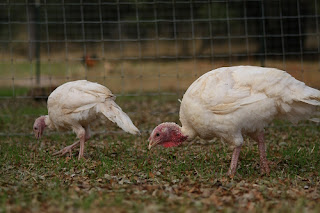Walle's Shadow
 Somewhere there is a farm. It is called a free-range farm, a euphemistic term meant to assuage guilt over consuming the flesh of another. On this farm live turkeys, white and big and perfect. Though they have some open space to enjoy, mostly they are confined by the thousands in sheds. Their toes have been cut off at the first digit to make picking them up for slaughterhouse transport easier. A portion of their upper beak has been seared off to make confining too many social animals together safer.
Somewhere there is a farm. It is called a free-range farm, a euphemistic term meant to assuage guilt over consuming the flesh of another. On this farm live turkeys, white and big and perfect. Though they have some open space to enjoy, mostly they are confined by the thousands in sheds. Their toes have been cut off at the first digit to make picking them up for slaughterhouse transport easier. A portion of their upper beak has been seared off to make confining too many social animals together safer.In a couple weeks, they will all be dead, victims of a holiday that is, at its core, about gratitude and compassion. These turkeys will be a part of the Thanksgiving dinner in the most horrific way - as the main course.
All but one.
One turkey "saved herself". This should not imply the other turkeys want death. They do not. Like all creatures on this earth, they too want to live, breath, exist. It's such a basic thing.
Walle wandered off the farm, forgotten by the turkey farmer. She walked and walked, placing one mangled foot in front of the other until finally, finally!, she was picked up. We are all grateful it was someone who saw a needy animal, not a turkey dinner.
 When Walle arrived, she was sick with a respiratory illness, probably brought on by both the unsanitary and unnatural living conditions as much as wandering alone int he world. Through it all, her drive to be part of something inspired us all. Each morning, she greeted us with the innocent calls of a young turkey, calling us over to her for attention. She would gobble up her food and then nestle down next to our laps, always after climbing up on us and inspecting our faces. Her world was such a brutal, uncaring place, and yet through all that, she gave us reason to be thankful.
When Walle arrived, she was sick with a respiratory illness, probably brought on by both the unsanitary and unnatural living conditions as much as wandering alone int he world. Through it all, her drive to be part of something inspired us all. Each morning, she greeted us with the innocent calls of a young turkey, calling us over to her for attention. She would gobble up her food and then nestle down next to our laps, always after climbing up on us and inspecting our faces. Her world was such a brutal, uncaring place, and yet through all that, she gave us reason to be thankful.After treating her respiratory sickness, she entered her own special flock. White-breasted turkeys are bred to gain a gross amount of weight in a short period of time. They are bred to be obese so they can be killed younger. All turkeys killed in this country are babies - 4-6 months of age, a mere 5-7% of their normal lifespan (for wild turkeys in captivity, it would be longer). So Walle lives with "broilers", chickens raised for meat consumption, and one other female production turkey, Marjorie.
Normally when a young turkey meets an adult, it is they who follow the grown-up, watching and learning. Our expectation was for Marjorie to become a teacher to Walle, show her the ropes, help her find all the good eating and sleeping spots.
We were wrong.
Walle is a leader. Where she goes, Marjorie follows.
This Thanksgiving, Walle would like nothing more than to crawl in your lap and sing to you. She would regale you with turkey tales, tell you stories of her kind in her own words. Everything in her world, she would want to share with you. That is her nature, that is who she is. We are grateful for this simple love of life, for her existence. She has enriched our world, and we hope to have enriched hers.
Have a Happy Vegan Thanksgiving! If this is not possible, if you are amidst people who do not understand, Walle does. Come back to these pictures and know you are, in her eyes, perfect and amazing and the purveyor of chest scratches, food, and good company. She exists because you care. Thank you.
Protest Live Chicken Vendors in San Francisco
Protest Live Chicken Vendors in San Francisco
October 5, 2010

It is still legal in some areas of San Francisco to sell live birds from egg farms to individuals who slaughter them without legal oversight. These birds are shipped from commercial egg farms and sold at these live markets.
Many of these birds are sold near or in farmers' markets without any public safety measures in place to prevent cross-contamination.
LGBT Compassion is planning a protest of selling live birds at the Heart of the City Farmer's Market on Sunday, October 10th from 9-12 pm. If you wish to join in the protest, please email Alex Felsinger.
Stop Live Birth Exhibits at California State Fair
During the California State Fair, a pregnant cow escaped prior to the fair opening and was eventually shot and killed. The cow was part of the live birth exhibit in which heavily pregnant animals are transported from farms and forced to give birth in front of spectators.
Every year, thousands of cows, goats, sheep and pigs are transported during the last 10% of their pregnancy to be part of live birth exhibits at both county and state fairs. While supporters claim these offer educational insight on the "miracle of birth", there is no scientific study to support that claim. There is, however, ample evidence that the transport of heavily pregnant animals is damaging to the health and welfare of both mother and offspring. Further, cows and pigs prefer giving birth in solitude, not in public, yet they cannot escape gawking onlookers at the fair.
Pregnant sows (pigs) are confined in crates so small they cannot turn around. These farrowing crates severely restrict the sow's movement. Supporters claim this will prevent her from eating or crushing the piglets, yet somehow pigs on free-range operations and at sanctuaries manage to avoid doing this.
The welfare concerns of live birth exhibits significantly outweigh any educational value the public may have. The shooting death of the pregnant cow at the California State Fair only highlights the underlining issue, that pregnant animals should not be transported and put on display during the sensitive, stressful birthing process.
Tell the California State Fair Board that live birth exhibits have no place at the State Fair.
Sign the petition today!
Every year, thousands of cows, goats, sheep and pigs are transported during the last 10% of their pregnancy to be part of live birth exhibits at both county and state fairs. While supporters claim these offer educational insight on the "miracle of birth", there is no scientific study to support that claim. There is, however, ample evidence that the transport of heavily pregnant animals is damaging to the health and welfare of both mother and offspring. Further, cows and pigs prefer giving birth in solitude, not in public, yet they cannot escape gawking onlookers at the fair.
Pregnant sows (pigs) are confined in crates so small they cannot turn around. These farrowing crates severely restrict the sow's movement. Supporters claim this will prevent her from eating or crushing the piglets, yet somehow pigs on free-range operations and at sanctuaries manage to avoid doing this.
The welfare concerns of live birth exhibits significantly outweigh any educational value the public may have. The shooting death of the pregnant cow at the California State Fair only highlights the underlining issue, that pregnant animals should not be transported and put on display during the sensitive, stressful birthing process.
Tell the California State Fair Board that live birth exhibits have no place at the State Fair.
Sign the petition today!
Animal Place Photo Flashback - Summer and Freedom
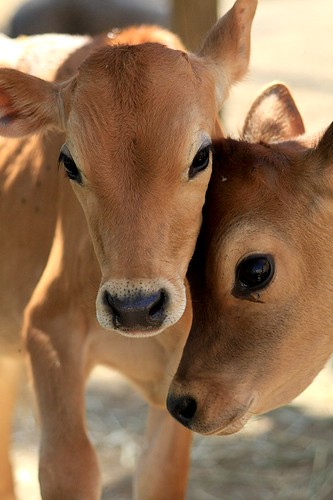
August 8, 2009
This is an iconic shot of Summer and Freedom, two male calves rescued from auction. Like all dairy calves, Summer and Freedom were deprived of their mother, having been taken away from her right after birth. Here, they take comfort in one another. They are a little older than two months in this photo.
You can have your own copy of this beautiful photo. Each photo is matted on 11x17 archival quality mat. The photo is 8x10" and full color. Buy one here and support the efforts of Animal Place.
Animal Place Photo Flashback - Frank Potbelly Pig
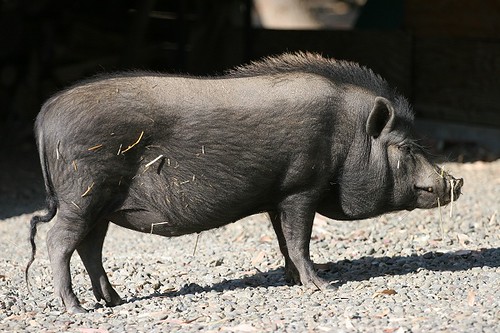
Photo: August 7, 2009
Frank is one of 7 potbellied pigs at the sanctuary. He arrived in 2004 along with two other pigs. They came from a southern California neglect case. A man had 6 pigs and in two years, he ended up with 300 on less than an acre of land.
It takes a full five years for potbellied pigs to reach their full size. Potbellied pigs can make wonderful companions, but require extensive and often specialized care. Obesity and arthritis are a constant concern. Do your research before adopting one.
Labels:
pictures,
potbellied pigs,
sanctuary residents
Animal Place Photo Flashback - Copper Chicken
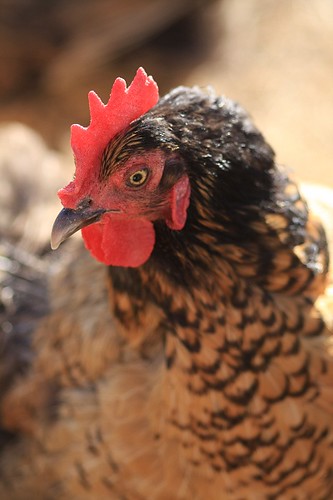
Photo: August 6, 2010
Copper is a gold-laced orpington, another breed popular with backyard chicken enthusiasts. Like many chickens at the sanctuary, Copper is the result of the backyard chicken craze. She and three other orpingtons were purchased as chicks from a feed-store. These chicks came from a large hatchery where they were born in an incubator, not in a nest. Their parents live in small cages and are used as breeding machines.
Chickens were illegal where the woman lived. While chickens make wonderful companion animals, it is important to do proper research before bringing one home. Adopt chickens - don't buy from a feed-store or a hatchery.
Labels:
chickens,
pictures,
sanctuary residents
Animal Place Photo Flashback - Boris Rabbit
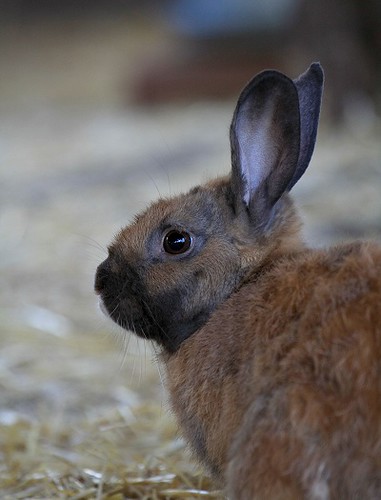
Photo Taken: August 5, 2009
Boris is one of more than a hundred rabbits rescued from a school-yard. Years ago, a teacher with a few intact rabbits decided they weren't worth the effort. Instead of finding placement for them, this educator taught a bad lesson - she released them on the school grounds. Soon the place became a dumping ground for unwanted rabbits. Rampant breeding led to an explosion in the population. School officials wanted to kill the rabbits, but rescuers intervened and achieved a legal victory. Instead of death, rescuers would capture the rabbits, neuter them, and place them into homes or sanctuaries. Animal Place took in seven.
Rabbits can make wonderful companions, but it is important to research their care first. They prefer a less hands-on approach to their care and, as prey animals, can perceive being held as an attack. They do best with older children and adults, as most rabbits do not enjoy the grabby and often frenetic energy of young children. They can live 8-12 years and a cage should NEVER be their primary method of confinement.
Labels:
pictures,
rabbits,
sanctuary residents
Will Tuttle Speaks About Animal Place
Will Tuttle, Ph.D, author of The World Peace Diet, visited Animal Place and shared his thoughts with us.
The spirit of Animal Place is compassion in action. Pigs here are finally free to wander, root, and relax on acres of beautiful land, and hens to dust bathe and socialize happily. Organic gardens, fields, and forests are woven thoughtfully with well-constructed new barns and fencing so that there is ample space for the cows, goats, rabbits, turkeys, and other animals who have been rescued from the violence of meat, dairy, and egg production.
This is a place of education also: both learning and unlearning. Seeing the unique and vivid personalities of the animals who are respected and treated as subjects rather than as objects, we can unlearn the delusions that contribute to our violence, and begin to understand our proper relationship with the Earth and her creatures, and with each other. Animal Place is a wondrous place for children—petting a little goat, rubbing a pig’s belly, and feeding the chickens and turkeys connects us all with the child within who naturally sees with eyes of inclusion.
Through the hard work and vision of founder Kim Sturla and the dedicated staff, and the generosity and foresight of thousands of contributors and volunteers, Animal Place has been able to move from over-cramped facilities in Vacaville to a magnificent 600 acres of water-rich land in Grass Valley in the foothills of the Sierra Nevada. Large enough for a wildlife sanctuary and a sanctuary for rescued farmed animals, there will also be educational programs to help people deepen their connection with their innate compassion and wisdom.
Visiting Animal Place is visiting the future: a future where we will all be more sensitive and aware of the interconnectedness of all life, and live a deeper understanding that life is a celebration, not a competition.
Animal Place is a community in the best sense – a place of cooperation and caring, of idealism and practicality—a vision of the best in humanity, and of the beautiful world we can create together as we awaken from the trance of exclusion and the illusion that might makes right. Animal Place is a place where we, as a culture, are growing exciting and positive new dreams together.
Animal Place Photo Flashback - Looloo Hen
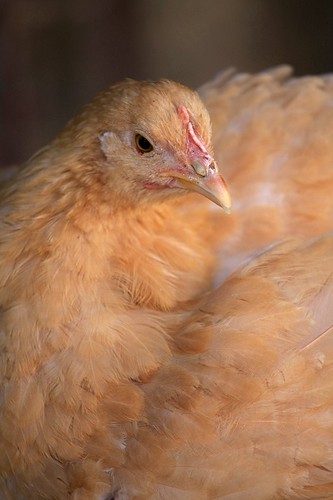
Photo: August 4, 2009
Loo-loo turned one this year in May. She is one of many faces from the backyard chicken craze. When, as a young chick, she was no longer wanted, Loo-loo was set free. The poult wandered into a backyard where several feral cats ended up attacking her. The owners of the home took her in and cared for her wounds. When she was healthy, they contacted Animal Place. How could we say no? Loo-loo is a buff orpington, a breed of chicken raised for their flesh and sometimes eggs. At the sanctuary, Loo-loo gets to be herself. She is one of the friendlier chickens and enjoys sitting on laps.
Animal Place Photo Flashback - Zarriah
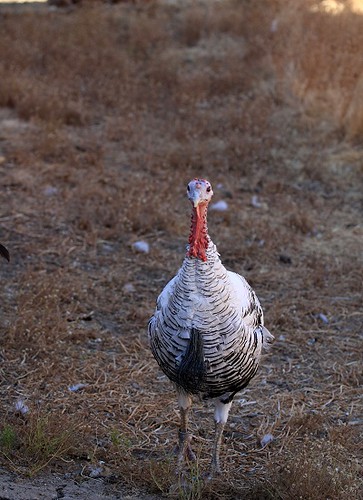
Zarriah is a royal palm turkey. This is a "heritage breed" of turkey. Zarriah came from a meat-farm where "heritage" turkeys are raised for slaughter. She wandered away from the farm and was found loose in the streets of Napa. Her rescuer couldn't bear the thought of the turkey being killed, so she contacted Animal Place. That was in 2000 - Zarriah turns 10 this month!
Animal Place Photo Flashback - Iris Rabbit

Photo: July 13, 2009
Iris is a hoppity-bunny rabbit with soft fur and a gentle disposition. She was rescued from a neglect case in 2007, where she lived in a small, wire cage with 10 other rabbits. With barely any room to move, Iris and her bunny friends would probably not survive long. Thankfully, animal control confiscated her and the other rabbits. They found homes, while Iris came to live out her life at the sanctuary.
Animal Welfare Victories
This week, the California Governor signed into law a bill that would require all eggs sold in California to comply with the standards approved by voters in 2008. Proposition 2 requires that hens in the egg industry, male calves in the veal industry, and pregnant sows have enough room to stand up, lie down, turn around, and stretch their limbs without touching the sides of their enclosure. An extremely modest proposal, really.
Egg producers opined that all egg production would go out of state where housing standards may be more lax. That loop-hole has now been closed - if producers in other states wish to sell their eggs in California, they must comply with the state's "welfare" standards.
This should not be construed as a complete and resounding victory for hens in the egg industry. The only true victory is when there are no hens being raised and slaughtered for their eggs. We will work toward that goal on multiple fronts, including supporting legislation like the one signed by the Governor and heavily promoting the transition to a vegan diet.
Meanwhile in Ohio, the signature gathering process to put farmed animal welfare issues on the ballot has stopped. Animal welfare agencies and agribusiness sat down and hashed out a compromise including a phase-out on veal crates, gestation crates, a moratorium on new battery-cage operations, a ban on transporting downed animals, and a prohibition on certain methods of killing farmed animals (including strangulation).
While these are definitive animal welfare victories, the best and easiest way you can help animals is adopting a vegan diet. A vegan diet significantly reduces our negative impact on the non human animals, environment and our health. It's a win-win for all involved!
Egg producers opined that all egg production would go out of state where housing standards may be more lax. That loop-hole has now been closed - if producers in other states wish to sell their eggs in California, they must comply with the state's "welfare" standards.
This should not be construed as a complete and resounding victory for hens in the egg industry. The only true victory is when there are no hens being raised and slaughtered for their eggs. We will work toward that goal on multiple fronts, including supporting legislation like the one signed by the Governor and heavily promoting the transition to a vegan diet.
Meanwhile in Ohio, the signature gathering process to put farmed animal welfare issues on the ballot has stopped. Animal welfare agencies and agribusiness sat down and hashed out a compromise including a phase-out on veal crates, gestation crates, a moratorium on new battery-cage operations, a ban on transporting downed animals, and a prohibition on certain methods of killing farmed animals (including strangulation).
While these are definitive animal welfare victories, the best and easiest way you can help animals is adopting a vegan diet. A vegan diet significantly reduces our negative impact on the non human animals, environment and our health. It's a win-win for all involved!
Hens Available for Adoption
Last month, 200 hens arrived safe and sound from a small egg farm. They are the very first residents of Animal Place's Rescue Ranch, a 60-acre farmed animal adoption and placement center located on the former site of the Animal Place sanctuary.
The hens arrived with leg trauma. When they were young, the farm manager attempted a new identification system- plastic-coated, wire leg bands. Unfortunately, while the legs of the hens grew, the bands did not. More than 90% of the hens had deeply embedded leg bands, some to the bone.
It has taken almost two weeks of intensive care for the first group of birds to be ready for placement.
The manager will not be using these identification bands anymore.
We are placing the hens into permanent homes. Check out the adoption information below.
How to Adopt Hens
These hens are all commercial brown layer crosses. They have been bred to produce an amazing 250-300 eggs a year - 5 times more than normal. When their production decreases, they are generally sent to slaughter. They are 1.5 years old and can live another 6-7 years.
All the animals received by Rescue Ranch will be placed into permanent homes. Those who cannot be placed will be sent to the 600-acre sanctuary in Grass Valley, CA.
All of the rescued hens are available for adoption. If you are interested in adopting, please contact Marji Beach at marji@animalplace.org or 530-798-5114. You will be requested to fill out an adoption form and, if approved, pick-up of birds will be arranged. Adoption fees are to be paid upon pick-up of birds. The fees cover the care of the birds and allow us to continue our life-saving work. Any additional donations are greatly appreciated!
The adoption fees are as follows:
1-4 hens: $10/each
5-11 hens: $7/each
12+ hens: $5/each
About the Farms
Animal Place's Rescue Ranch is unique in that we work directly with farmers to provide an alternative to slaughter for a small percentage of hens in the egg laying industry. There are more than 15 million hens raised for eggs in California. Most will never find true sanctuary. The farms we work with range from small, pasture-based operations to larger facilities.
Animal Place is honest - we are a vegan organization promoting compassion to all life. We may never see eye to eye with farmers on some issues, but we hope to find common ground in order to save as many lives as possible. Toward that end, we keep all information about cooperating farmers private, and they reciprocate by not using Rescue Ranch as a tool to promote the consumption of their eggs. We do not bring cameras or recording equipment into the farm and both parties sign confidentiality agreements. Again, Rescue Ranch's goal is save as many lives as possible without compromising the integrity of our organization.
Dairy Farmers Waste Milk
On July 4th, participating dairy farmers plan on wasting a day's worth of milk to make a point. They aren't getting paid enough to maintain their dairy farms. So their solution for losing money is to squander a day's worth of milk.
This isn't anything new. Last year, European dairy farmers did the same thing. They dumped a whopping 6.6 million gallons of milk on their fields. Probably not the best way to feed your plants. Belgian dairy farmers alone dumped more than 750,000 gallons of milk.
Of course it is unfair to not be paid an appropriate price for the work you do.
But who is doing the work?
It isn't the humans. While a good farmer may work from sun-up to sun-down on the farm, a dairy cow's body works beyond that. She has been systematically bred to be a milk-producing machine, her body so focused on lactation to the utter detriment of her overall health. She is skinny. Her body is sending the message to lactate, lactate, lactate and the farmer doesn't help - s/he actually encourages the process by milking her. The cow does not have time or energy to spend on stuff like laying down fat or muscle, she must send all of her resources to her udder.
And that udder! It's huge. Sometimes so huge that it causes physical discomfort to the cow. She's dragging around an extra 30-50 lb appendage. Non dairy-breeds don't have that problem. They produce enough milk to satiate the natural thirst of their calves. Of course, humans don't care much about the natural thirst of a dairy cow's calf. In fact, calves get taken away the day they are born, generally minutes after birth. There is no nursing. Male calves get slaughtered, female calves live in isolation, then in small groups, and when their mom is slaughtered, they replace her.
What does the cow get paid? Nothing. As a final farewell, a final "thanks so much", she's killed. She is often lame from the inappropriate diet of grain she has been fed. Her udder is often riddled with infection. More often than not, at a young age, she is incapable of reproducing normally. In a natural setting, cows can remain reproductively sound into their early teens - the average lifespan of a cow on a beef cow-calf operation (she produces calves to send to slaughter) is 10-13 years. The average lifespan of a dairy cow is 4-6. Being bred nearly every single year is an enormous strain on her body. Her reproductive system, sooner than normal, finally just gives up under the stress.
Wasting this milk is an insult. It's bad enough these cows are bred and bred, made to produce ten times more milk than normal, denied normal cow-calf bonding, and then slaughtered...dairy farmers are now going to waste thousands, maybe millions, of gallons of milk? Thanks for adding insult to injury.
Go vegan. Happy cows love vegans.
This isn't anything new. Last year, European dairy farmers did the same thing. They dumped a whopping 6.6 million gallons of milk on their fields. Probably not the best way to feed your plants. Belgian dairy farmers alone dumped more than 750,000 gallons of milk.
Of course it is unfair to not be paid an appropriate price for the work you do.
But who is doing the work?
It isn't the humans. While a good farmer may work from sun-up to sun-down on the farm, a dairy cow's body works beyond that. She has been systematically bred to be a milk-producing machine, her body so focused on lactation to the utter detriment of her overall health. She is skinny. Her body is sending the message to lactate, lactate, lactate and the farmer doesn't help - s/he actually encourages the process by milking her. The cow does not have time or energy to spend on stuff like laying down fat or muscle, she must send all of her resources to her udder.
And that udder! It's huge. Sometimes so huge that it causes physical discomfort to the cow. She's dragging around an extra 30-50 lb appendage. Non dairy-breeds don't have that problem. They produce enough milk to satiate the natural thirst of their calves. Of course, humans don't care much about the natural thirst of a dairy cow's calf. In fact, calves get taken away the day they are born, generally minutes after birth. There is no nursing. Male calves get slaughtered, female calves live in isolation, then in small groups, and when their mom is slaughtered, they replace her.
What does the cow get paid? Nothing. As a final farewell, a final "thanks so much", she's killed. She is often lame from the inappropriate diet of grain she has been fed. Her udder is often riddled with infection. More often than not, at a young age, she is incapable of reproducing normally. In a natural setting, cows can remain reproductively sound into their early teens - the average lifespan of a cow on a beef cow-calf operation (she produces calves to send to slaughter) is 10-13 years. The average lifespan of a dairy cow is 4-6. Being bred nearly every single year is an enormous strain on her body. Her reproductive system, sooner than normal, finally just gives up under the stress.
Wasting this milk is an insult. It's bad enough these cows are bred and bred, made to produce ten times more milk than normal, denied normal cow-calf bonding, and then slaughtered...dairy farmers are now going to waste thousands, maybe millions, of gallons of milk? Thanks for adding insult to injury.
Go vegan. Happy cows love vegans.
California Rabbit Rescues Need Help
Northern Californian rabbit rescues have been slammed in the past weeks with several large rescues and cruelty cases. They need immediate help with placement and care of these rescued bunnies. Please look below to see if you can help these rabbits out.
Grass Valley, CA - 27 rabbits
The Grass Valley city shelter confiscated more than two dozen rabbits from an abandonment case in which the rabbits were left without food and water. These are incredibly social and friendly rabbits, mostly lion-rex mixes. Unfortunately, these are the exact opposite of the type of rabbits Animal Place can consider taking (and we could not take 27, by any stretch). These animals need to find homes as soon as possible. The city shelter is considering pressing animal cruelty charges, so it's wonderful they are taking this seriously.
Please contact the shelter at (530) 477-4630.
Martinez, CA - 100 rabbits
An individual involved in selling rabbits was found to have more than 100 rabbits in various stages of poor health, including several dead rabbits on site. The rabbits have been breeding uncontrollably. Many are young and will do well in a companion home. For more information, please visit this blog or Rabbit Haven and find out how you can help.
Grass Valley, CA - 27 rabbits
The Grass Valley city shelter confiscated more than two dozen rabbits from an abandonment case in which the rabbits were left without food and water. These are incredibly social and friendly rabbits, mostly lion-rex mixes. Unfortunately, these are the exact opposite of the type of rabbits Animal Place can consider taking (and we could not take 27, by any stretch). These animals need to find homes as soon as possible. The city shelter is considering pressing animal cruelty charges, so it's wonderful they are taking this seriously.
Please contact the shelter at (530) 477-4630.
Martinez, CA - 100 rabbits
An individual involved in selling rabbits was found to have more than 100 rabbits in various stages of poor health, including several dead rabbits on site. The rabbits have been breeding uncontrollably. Many are young and will do well in a companion home. For more information, please visit this blog or Rabbit Haven and find out how you can help.
Simon Sheep
Simon 9/7/2003-6/18/2010
This is your last photo, Simon. It captures your essence perfectly. Curious, gentle with a hint of jester lurking behind gold-hued eyes.
Nearly seven years ago, you arrived on a cool fall morning - a day-old lamb and already forsaken by the world. Your mom abandoned you and so had the farmer. Like your rescuer, we promised that would never happen again. Promises can be such tricky things.
The first time I interacted with you, you head-butted me. Nine-months-old and king of the world. I cannot pinpoint the exact moment when you started to mellow, wanting to receive scratches instead of knocking heads. Whenever it was, I'm sure we all heaved a sigh of relief - finally the king had matured.
Your love was Sophie and the sheep. You wanted nothing to do with the other animals, and focused your entire being on monitoring the flock. I think you filled up with joy each time a new sheep was added - your flock of four grew to eight, and you were content.
In the past year, I watched with pleasure as you sought out people on tours, reveling in their scratches and massages. No more head-butting for you!
Last year, you struggled to overcome bladder stones, mineral deposits that blocked your urethra and stopped you from urinating. The pain you endured was immense and two surgeries later, we hoped against all hopes that it would never happen again.
This past Tuesday, you went blind. Your gut was not working, not moving like it should. We knew that in ruminants, an improper working stomach spells disaster. We threw everything at you to transform sickness into health. When you refused to eat, we rushed you to the veterinary hospital.
You were blocked again. The first attempt at flushing the stones out failed. Surgery was your only option. When they opened you up, the damage was extensive. To fix you meant to hurt you more, and it did not come with a remote guarantee of success. The likelihood of recovery, of never having stones again was nil. This was your final surgery, if you got stones again, we could not help you. Recovery from this surgery is one of the most painful, almost as painful as the stones themselves.
Of course, you were asleep for all this. Unconscious.
Your life, your death - it all boiled down to ten wrenching moments in which we had to decide. Could we put you through months of recovery, then almost immediate blockage, out of a small, tiny hope that maybe, just maybe, you'd live a few months more? Is that what you wanted? Perhaps it was, and perhaps we failed you in the ways only humans can. Perhaps it wasn't.
We took your life because we wanted to take away your immense suffering and almost certain, painful death. Selfish and selfless, the dichotomy of being responsible for another living being's care.
I will hold dear the final moments spent with you. You could not see me, but when you sniffed my hand, I could feel you relax. As I scratched soft cheek and chin, massaged short wool, you leaned into me. We took comfort in each other, in the knowledge that cheek to cheek, we were safe.
We'll miss you Simon. Your mischievous glances, playful nudges, and insistent ploys of garnering attention. Sophie will miss you, her adopted brother, the one who protected and comforted her. The flock is empty without your calm presence. I'm incredibly sorry we could not heal you.
Cattle to New Pasture
Running a 600-acre sanctuary is a lot different than 60 acres! We want to preserve the integrity of the land and, to do that, we have to move animals to different pastures, rotating where they can graze.
Today, we moved the cattle to another pasture. We were not sure how quickly they'd head out through our makeshift chute, but we didn't have to wait long at all! The cattle knew what to do and as soon as we opened the gates, they were out into the new meadow, chomping away.
Enjoy the photos!




Today, we moved the cattle to another pasture. We were not sure how quickly they'd head out through our makeshift chute, but we didn't have to wait long at all! The cattle knew what to do and as soon as we opened the gates, they were out into the new meadow, chomping away.
Enjoy the photos!






Where Farmed Animals Are Handled With Care
Very soon, all the animals and staff at the current facility will be moving to the new 600-acre sanctuary in Grass Valley, Calif. This is both exciting and stressful!
Right now, we are set with hands-on help, but we could still use assistance with monetary donations. Want to help move a rabbit or a pig or maybe a cow? You can help moove the animals with care!
If you like the Handled With Care logo (and you should), then get some of your very own Animal Place gear through our cafepress store. You could be toting around your very own Handled with Care Sigg water bottle or wear the logo with pride on an organic t-shirt.
Check it out here.
Right now, we are set with hands-on help, but we could still use assistance with monetary donations. Want to help move a rabbit or a pig or maybe a cow? You can help moove the animals with care!
If you like the Handled With Care logo (and you should), then get some of your very own Animal Place gear through our cafepress store. You could be toting around your very own Handled with Care Sigg water bottle or wear the logo with pride on an organic t-shirt.
Check it out here.
Tell Buchheit Not to Give Away Free Chicks to Kids
Buchheit is a multi-purpose chain store that sells everything from farm equipment to building supplies.
In a horrible move, they are offering this Saturday a FREE baby chicken to every child.
Seriously?
This is just a bad idea on so many levels. Children are not responsible for the care of animals, their parents are, and how many are really capable of welcoming a chick, let alone an adult chicken, into their home. Is it legal? Do they have the right setup?
More thought than stopping by the local country store should go into welcoming an animal into your home. Impulse buys (and this one's free!) generally end poorly for the animals.
Please ask Buchheit NOT to follow through with this promotion. It teaches children and parents that animals are disposable and may result in the death and suffering of countless chickens.
Buchheit Corporate Office
33 P.C.R. 540
Perryville, MO 63775
(573)547-1010
Office Hours
Mon-Fri 8:00am to 5:00pm
http://www.buchheitonline.com/
Locations:
Buchheit of Perryville
1011 South Hwy 51
Perryville, MO 63775
(573)547-6565
Mon-Sat 7:00am to 8:00pm
Sunday 9:00am to 5:30pm
Buchheit of Jacksonville
2200 West Morton Ave.
Jacksonville, IL 62650
(217)245-4440
Mon-Sat 7:00am to 8:00pm
Sunday 9:00am to 5:30pm
Buchheit of Herculaneum
200 Riverview
Herculaneum, MO 63048
(636)475-6020
Mon-Sat 7:00am to 9:00pm
Sunday 8:00am to 6:00pm
Buchheit of Sparta
1817 North Market
Sparta, IL 62286
(618)443-2455
Mon-Sat 8:00am to 8:00pm
Sunday 9:00am to 5:30pm
Buchheit of Jackson
2801 Old Orchard Rd.
Jackson, MO 63755
(573)204-1700
Mon-Sat 7:00am to 9:00pm
Sunday 9:00am to 5:30pm
Buchheit of Greenville
1400 E. City Rt. 40
Greenville, IL 62246
(618)664-9100
Store Hours
Mon-Sat 8:00am to 8:00pm
Sunday 9:00am to 5:30pm
Buchheit of Centralia
1045 W. Broadway
In the Fairview Park Plaza
Centralia, IL 62801
(618)533-3850
Mon-Sat 8:00am to 8:00pm
Sunday 9:00am to 5:30pm
In a horrible move, they are offering this Saturday a FREE baby chicken to every child.
Seriously?
This is just a bad idea on so many levels. Children are not responsible for the care of animals, their parents are, and how many are really capable of welcoming a chick, let alone an adult chicken, into their home. Is it legal? Do they have the right setup?
More thought than stopping by the local country store should go into welcoming an animal into your home. Impulse buys (and this one's free!) generally end poorly for the animals.
Please ask Buchheit NOT to follow through with this promotion. It teaches children and parents that animals are disposable and may result in the death and suffering of countless chickens.
Buchheit Corporate Office
33 P.C.R. 540
Perryville, MO 63775
(573)547-1010
Office Hours
Mon-Fri 8:00am to 5:00pm
http://www.buchheitonline.com/
Locations:
Buchheit of Perryville
1011 South Hwy 51
Perryville, MO 63775
(573)547-6565
Mon-Sat 7:00am to 8:00pm
Sunday 9:00am to 5:30pm
Buchheit of Jacksonville
2200 West Morton Ave.
Jacksonville, IL 62650
(217)245-4440
Mon-Sat 7:00am to 8:00pm
Sunday 9:00am to 5:30pm
Buchheit of Herculaneum
200 Riverview
Herculaneum, MO 63048
(636)475-6020
Mon-Sat 7:00am to 9:00pm
Sunday 8:00am to 6:00pm
Buchheit of Sparta
1817 North Market
Sparta, IL 62286
(618)443-2455
Mon-Sat 8:00am to 8:00pm
Sunday 9:00am to 5:30pm
Buchheit of Jackson
2801 Old Orchard Rd.
Jackson, MO 63755
(573)204-1700
Mon-Sat 7:00am to 9:00pm
Sunday 9:00am to 5:30pm
Buchheit of Greenville
1400 E. City Rt. 40
Greenville, IL 62246
(618)664-9100
Store Hours
Mon-Sat 8:00am to 8:00pm
Sunday 9:00am to 5:30pm
Buchheit of Centralia
1045 W. Broadway
In the Fairview Park Plaza
Centralia, IL 62801
(618)533-3850
Mon-Sat 8:00am to 8:00pm
Sunday 9:00am to 5:30pm
Goat and Sheep: Play Fighting, Interesting Behavior
If you have an interest in inter-species play/fight behavior, then watch this video I took yesterday. Otherwise, it might be rather boring. You have been warned.
Animal Place is home to 11 goats and 8 sheep. The sheep have learned goats are more aggressive than they and many have horns. Every now and then, a younger sheep will show an interest in interacting with one of the goats.
Lenny, a 2-yr-old Merino wether (neutered) and Annie, a middle-aged Boer doe, began the dance of play. Some may argue they are displaying signs of dominance, but Lenny’s lack of intense aggression leads me to believe they are more play than actual fight. Further, Annie shows incredible restraint when she head-butts Lenny.
Sheep and goats are different in obvious and not-so-obvious ways. Goats are browsers while sheep are grazers – both are ruminants, with a four-chambered stomach. The horns on goats and sheep differ. When approached by potential predators, sheep form a tight flock and tend to run away. Goats tend to form a tight herd, turn to face the predator in a straight line, and only back down if forced to (I’ve seen foolish dogs head-butted and tossed by goats). There is one sheep at Animal Place who acts like a goat when faced with a dog, and he once “saved” the sheep flock from a roaming Border Collie by charging down the hill and chasing the dog off. (He came up to me quite pleased with himself). So, of course, there are individual variances and personalities.
When fighting, sheep back up and charge; goats circle around, move a few feet away, rear up at an angle, and then land hard for the head-butt. The fighting “head-butt” behavior is also a form of play and a way to interact socially with conspecifics and, dangerously, sometimes with humans as well.
The Video
Annie exhibits classic goat head-butting behavior. Lenny does not exhibit classic sheep head-butting behavior and tries, in his own small way, to emulate Annie. He does not have the behavioral inclination to rear up or angle himself, but you can see him try a couple of times to hop a little before butting heads.
You can also see how restrained Annie is in her rearing and butting behavior. Instead of ramming full-force, she slows slightly before making contact with Lenny. I think this shows Annie’s ability to modify her behavior to accommodate Lenny. She does not do this with goats.
You’ll see a white sheep, Simon, come in for a closer inspection and back away quite quickly when he realizes there’s a goat involved. I am certain he thinks Lenny is nuts.
Lenny is naturally polled – he was born without horns. As you can plainly see, Annie has horns.The only time Lenny becomes uncomfortable is when Annie's horns encounter his unnatural wool and snag.
After a bit, Lenny becomes clearly uncomfortable. He pulls back and starts to grind his teeth (it looks like he is chewing his cud). But Annie’s not giving up and they smash heads again. About 30 seconds later (not in video), Laura comes over and intervenes. You can see and hear the distinct difference between two horned goats head-butting and what you’ve been seeing between Annie and Lenny. It’s not just the sound, either, it’s the force. Annie has really been restraining herself with Lenny but does not do so w/ Laura.
I love the moment after. Laura standing proud in the middle, a referee. Annie is annoyed off to the side and Lenny isn’t sure what to do. But I think he’s probably relieved.
And just for sake of comparison, I kept in when Annie and Laura continue their “fight”. You can see the difference in force. Laura does not rear up a lot because she was dragged around by a broken front leg before arriving at the sanctuary. It healed but not completely.
I like what this video conveys: Nonhuman animals can adjust their behavior to accommodate others. Individuals can show curiosity and avoidance or show curiosity and interference. Sheep are not all “sheep” – Simon would not do what Lenny did. Goats are not all “goats” – one of the other goats would have hurt Lenny, but Annie adjusted to his behavior.
Animal Place is home to 11 goats and 8 sheep. The sheep have learned goats are more aggressive than they and many have horns. Every now and then, a younger sheep will show an interest in interacting with one of the goats.
Lenny, a 2-yr-old Merino wether (neutered) and Annie, a middle-aged Boer doe, began the dance of play. Some may argue they are displaying signs of dominance, but Lenny’s lack of intense aggression leads me to believe they are more play than actual fight. Further, Annie shows incredible restraint when she head-butts Lenny.
Sheep and goats are different in obvious and not-so-obvious ways. Goats are browsers while sheep are grazers – both are ruminants, with a four-chambered stomach. The horns on goats and sheep differ. When approached by potential predators, sheep form a tight flock and tend to run away. Goats tend to form a tight herd, turn to face the predator in a straight line, and only back down if forced to (I’ve seen foolish dogs head-butted and tossed by goats). There is one sheep at Animal Place who acts like a goat when faced with a dog, and he once “saved” the sheep flock from a roaming Border Collie by charging down the hill and chasing the dog off. (He came up to me quite pleased with himself). So, of course, there are individual variances and personalities.
When fighting, sheep back up and charge; goats circle around, move a few feet away, rear up at an angle, and then land hard for the head-butt. The fighting “head-butt” behavior is also a form of play and a way to interact socially with conspecifics and, dangerously, sometimes with humans as well.
The Video
Annie exhibits classic goat head-butting behavior. Lenny does not exhibit classic sheep head-butting behavior and tries, in his own small way, to emulate Annie. He does not have the behavioral inclination to rear up or angle himself, but you can see him try a couple of times to hop a little before butting heads.
You can also see how restrained Annie is in her rearing and butting behavior. Instead of ramming full-force, she slows slightly before making contact with Lenny. I think this shows Annie’s ability to modify her behavior to accommodate Lenny. She does not do this with goats.
You’ll see a white sheep, Simon, come in for a closer inspection and back away quite quickly when he realizes there’s a goat involved. I am certain he thinks Lenny is nuts.
Lenny is naturally polled – he was born without horns. As you can plainly see, Annie has horns.The only time Lenny becomes uncomfortable is when Annie's horns encounter his unnatural wool and snag.
After a bit, Lenny becomes clearly uncomfortable. He pulls back and starts to grind his teeth (it looks like he is chewing his cud). But Annie’s not giving up and they smash heads again. About 30 seconds later (not in video), Laura comes over and intervenes. You can see and hear the distinct difference between two horned goats head-butting and what you’ve been seeing between Annie and Lenny. It’s not just the sound, either, it’s the force. Annie has really been restraining herself with Lenny but does not do so w/ Laura.
I love the moment after. Laura standing proud in the middle, a referee. Annie is annoyed off to the side and Lenny isn’t sure what to do. But I think he’s probably relieved.
And just for sake of comparison, I kept in when Annie and Laura continue their “fight”. You can see the difference in force. Laura does not rear up a lot because she was dragged around by a broken front leg before arriving at the sanctuary. It healed but not completely.
I like what this video conveys: Nonhuman animals can adjust their behavior to accommodate others. Individuals can show curiosity and avoidance or show curiosity and interference. Sheep are not all “sheep” – Simon would not do what Lenny did. Goats are not all “goats” – one of the other goats would have hurt Lenny, but Annie adjusted to his behavior.
Labels:
goats,
sanctuary residents,
sheep,
video
Sophie Sheep
Photo Art for Animal Place
Photos of Sanctuary Animals
Every animal at the sanctuary is precious and for visitors, it’s hard not to want to bring them home! Well, now you can! Welcome one of the Animal Place residents into your home with a matted photo. Even if you haven’t visited the sanctuary, welcome a bit of it into your home! And know that a portion of your purchase directly benefits the animal in the picture and all the animals at the sanctuary!
Each photo is 8x10” printed on acid-free paper on an 11x14” mat and secured in a poly-bag. Each photo is attached in such a way that you can re-frame or re-mat, if you prefer.
Is this a gift? Make sure to include the recipient’s address in the “merchant notes” block.
Each photo is $18. Purchase three and receive a 20% discount – only $43.00! Please specify which three you want in the “merchant notes” section.
Choose from:
Gilbert the Goat - 5 LEFT
Finnegan the Rooster -
Nicholas the calf - 4 LEFT
Summer & Freedom the calves - IN STOCK
Virginia &Lenny the sheep - 14 LEFT
Every animal at the sanctuary is precious and for visitors, it’s hard not to want to bring them home! Well, now you can! Welcome one of the Animal Place residents into your home with a matted photo. Even if you haven’t visited the sanctuary, welcome a bit of it into your home! And know that a portion of your purchase directly benefits the animal in the picture and all the animals at the sanctuary!
Each photo is 8x10” printed on acid-free paper on an 11x14” mat and secured in a poly-bag. Each photo is attached in such a way that you can re-frame or re-mat, if you prefer.
Is this a gift? Make sure to include the recipient’s address in the “merchant notes” block.
Each photo is $18. Purchase three and receive a 20% discount – only $43.00! Please specify which three you want in the “merchant notes” section.
Choose from:
Gilbert the Goat - 5 LEFT
Finnegan the Rooster -
Nicholas the calf - 4 LEFT
Summer & Freedom the calves - IN STOCK
Virginia &Lenny the sheep - 14 LEFT
The Stare of Sadie
On a cool, foggy morning I crouch next to her, scratching her neck as she stretches, and angles for the optimal position. The emerging sun glints off her hair, reflects back. She looks into my eyes. I gaze back into brown-black pools of what? Intelligence? Thought? Emotions? That and more? We had never communicated like this before – she, a cow; me, a human. For years, I tried to make eye contact, to convey my love, respect, joy at being near her. And, she would look away, shake her head, throw off my advances. Not today.
Sadie is a steady being, a painful one, a creature who is sometimes a complete mystery to me, sometimes a bright light of clarity. I fumble in my friendship with her. She tolerates my awkward attempts at communication, endures my steady hope that today, today is the day we understand each other.
Who is Sadie?
To know Sadie now, you must know who she was…or perhaps, wasn’t.
You can read more over at Animal Rights and AntiOppression
Sadie is a steady being, a painful one, a creature who is sometimes a complete mystery to me, sometimes a bright light of clarity. I fumble in my friendship with her. She tolerates my awkward attempts at communication, endures my steady hope that today, today is the day we understand each other.
Who is Sadie?
To know Sadie now, you must know who she was…or perhaps, wasn’t.
You can read more over at Animal Rights and AntiOppression
New York Dairy Investigation - not limited to factory farms
Mercy for Animals recently investigated a large, New York dairy farm. ABC News and Nightline both covered the story. Follows is video footage. Please be warned, some of the content may be difficult to watch.
The video is not easy to view. I love cows, they are my favorite of the large farmed animals. Two cows on a small dairy farm in northern California inspired me to go vegan. At the sanctuary, there is Sadie, a cow who I am honored to know and love. She too came from a small dairy farm and her life was miserable - she was tail-docked, de-horned, and deprived of her babies time and time again.
Practices Common on Most Dairy Farms
Tail docking occurs on farms of ALL sizes, not just factory farms. Approximately 1/3 of all dairy cows endure the amputation of their tail without pain relief. The American Veterinary Medical Association and the Association of Bovine Practitioners oppose this practice.
Dehorning without pain relief occurs on ALL farms, not just factory farms.
Maternal deprivation occurs on ALL farms, not just factory farms. 100% of all male calves are removed from their mothers the day they are born. 97% of all female calves are removed from their mom within the first 24-hours of birth.
Only 1.7% of the nine million cows in the United States spend most or all their time grazing on pasture. Approximately 75% of all dairy cows never see pasture or graze green grass.
The only practice not common on dairy farms, though often brought up in these discussions, is the use of growth hormone - only 17% of cows in lactation are injected with the hormone. Most dairy cows have been artificially selected to produce 8-10 times more milk than a normal cow would.
So, let's be clear - these horrible things you see in the video? They are not merely restricted to "factory farms". They happen on most farms. Choosing a "less cruel" milk is not making the "most compassionate" decision - becoming vegan is.
The video is not easy to view. I love cows, they are my favorite of the large farmed animals. Two cows on a small dairy farm in northern California inspired me to go vegan. At the sanctuary, there is Sadie, a cow who I am honored to know and love. She too came from a small dairy farm and her life was miserable - she was tail-docked, de-horned, and deprived of her babies time and time again.
Practices Common on Most Dairy Farms
Tail docking occurs on farms of ALL sizes, not just factory farms. Approximately 1/3 of all dairy cows endure the amputation of their tail without pain relief. The American Veterinary Medical Association and the Association of Bovine Practitioners oppose this practice.
Dehorning without pain relief occurs on ALL farms, not just factory farms.
Maternal deprivation occurs on ALL farms, not just factory farms. 100% of all male calves are removed from their mothers the day they are born. 97% of all female calves are removed from their mom within the first 24-hours of birth.
Only 1.7% of the nine million cows in the United States spend most or all their time grazing on pasture. Approximately 75% of all dairy cows never see pasture or graze green grass.
The only practice not common on dairy farms, though often brought up in these discussions, is the use of growth hormone - only 17% of cows in lactation are injected with the hormone. Most dairy cows have been artificially selected to produce 8-10 times more milk than a normal cow would.
So, let's be clear - these horrible things you see in the video? They are not merely restricted to "factory farms". They happen on most farms. Choosing a "less cruel" milk is not making the "most compassionate" decision - becoming vegan is.
Vegan Bake Sales
If you want to help with the relief efforts in Haiti while also eating tasty, vegan goods, then check out the list below and see if any vegan bake sales are going on near you.
Animal Place staff will be baking and tabling at the Sugar Plum Vegan Cafe in Sacramento - come by and say hi! Also, eat food!
California
1/23 (Sat) Sacramento
Sugar Plum Vegan Cafe
2315 K Street
11:00 – 3:00 pm
Benefits Food for Life Global
1/23 (Sat) San Francisco
Patricia’s Green
Hayes St. at Octavia
11:00 – 4:00 pm
1/31 (Sun) Los Angeles
Locali
5825 Franklin Ave
11:00-4:00 pm
Benefits Doctors without Borders
Minnesota
1/30 (Sat) Minneapolis
Ethique Nouveau
317 West 48th St
12:00-5:00 pm
Nebrasaka
1/24 (Sun) Omaha
McFoster’s Natural Kind Cafe
302 S. 38th St
12:00-2:00 pm
Benefits Mercy Corps
Nevada
1/26 (Tues) Las Vegas
UNLV Campus
4505 S Maryland Parkway
11:00-5:00 pm
More information here
New York
1/28 (Th) New York City
Angels and Kings
500 East 11th St.
7:00-9:00 pm
Benefits Sodoprec (Dominican veterinarians, site in Spanish)
1/31 (Sun) New York City
MooShoes
78 Orchard St.
11:30 – 6:00 pm
Benefits Doctors without Borders
Pennsylvania
1/24 (Sun) Philadelphia
25 E Street
Doyelstown
11:00 am
Ohio
1/23 (Sat) Akron
Vegiterranean
21 Furnace St.
11:00-5:00 pm
Benefits Doctors without Borders
Oregon
1/31 (Sun) Portland
People’s Coop
3029 Southeast 21st Ave.
2:00-5:00 pm
Benefits Mercy Corps
Texas
1/24 (Sun) Houston
Mango’s Vegetarian Cafe
403 Westheimer
12:00-4:00 pm
Benefits Food for Life Global and ARCH
More information here and flyer here
Washington
1/31 (Sun) Seattle
Neptune Coffee
8415 Greenwood Ave North
2:00-5:00 pm
Benefits Partners in Health
Facebook invite page here.
Washington D.C.
DC Vegans
1/24 (Sun) DC
Takoma Park Farmer’s Market
Carroll Ave & Laurel Ave
10:00-2:00 pm
Facebook Event Page
Benefits Mercy Corps
Animal Place staff will be baking and tabling at the Sugar Plum Vegan Cafe in Sacramento - come by and say hi! Also, eat food!
California
1/23 (Sat) Sacramento
Sugar Plum Vegan Cafe
2315 K Street
11:00 – 3:00 pm
Benefits Food for Life Global
1/23 (Sat) San Francisco
Patricia’s Green
Hayes St. at Octavia
11:00 – 4:00 pm
1/31 (Sun) Los Angeles
Locali
5825 Franklin Ave
11:00-4:00 pm
Benefits Doctors without Borders
Minnesota
1/30 (Sat) Minneapolis
Ethique Nouveau
317 West 48th St
12:00-5:00 pm
Nebrasaka
1/24 (Sun) Omaha
McFoster’s Natural Kind Cafe
302 S. 38th St
12:00-2:00 pm
Benefits Mercy Corps
Nevada
1/26 (Tues) Las Vegas
UNLV Campus
4505 S Maryland Parkway
11:00-5:00 pm
More information here
New York
1/28 (Th) New York City
Angels and Kings
500 East 11th St.
7:00-9:00 pm
Benefits Sodoprec (Dominican veterinarians, site in Spanish)
1/31 (Sun) New York City
MooShoes
78 Orchard St.
11:30 – 6:00 pm
Benefits Doctors without Borders
Pennsylvania
1/24 (Sun) Philadelphia
25 E Street
Doyelstown
11:00 am
Ohio
1/23 (Sat) Akron
Vegiterranean
21 Furnace St.
11:00-5:00 pm
Benefits Doctors without Borders
Oregon
1/31 (Sun) Portland
People’s Coop
3029 Southeast 21st Ave.
2:00-5:00 pm
Benefits Mercy Corps
Texas
1/24 (Sun) Houston
Mango’s Vegetarian Cafe
403 Westheimer
12:00-4:00 pm
Benefits Food for Life Global and ARCH
More information here and flyer here
Washington
1/31 (Sun) Seattle
Neptune Coffee
8415 Greenwood Ave North
2:00-5:00 pm
Benefits Partners in Health
Facebook invite page here.
Washington D.C.
DC Vegans
1/24 (Sun) DC
Takoma Park Farmer’s Market
Carroll Ave & Laurel Ave
10:00-2:00 pm
Facebook Event Page
Benefits Mercy Corps
Peas in a Pod
Well, more like mirroring cows!
Summer and Freedom are six-months old and like to copy whatever the adults are doing. So when they saw Nicholas (2) and Elsa (15) bonding through some head pushing, they had to be just like them!
Summer and Freedom are six-months old and like to copy whatever the adults are doing. So when they saw Nicholas (2) and Elsa (15) bonding through some head pushing, they had to be just like them!
Pretty cute stuff, huh?
Freedom is on the left - he's a bit more bloated, because he was born with a congenital defect. His tail is missing and his anus is in the wrong spot, which gives him some digestive and pooping problems. Summer is on the right and in really great health.
In the background, Nicholas is on the left - he just turned 2 in December. Elsa, the old lady cow of the herd is 15 and on the right.
Labels:
cattle,
pictures,
sanctuary life,
sanctuary residents
Volunteer Orientations
If you are in the Grass Valley/Sacramento/Auburn/Nevada City region and want to help farmed animals, consider joining us at one of our volunteer orientations. If you are a brave Bay Area farmed animal lover, we welcome you too!
Below are the three upcoming orientations. They will be held in Grass Valley, California. The sanctuary will be moving in April and the first orientation occurs at the end of May. We will try and have an orientation each month. In order to volunteer at the sanctuary, you must attend an orientation.
To register for the orientations, click on the links below.
Saturday, May 22nd from 11:30-3:30 pm - Register here
Wednesday, June 16 from 10:00-2:00 pm - Register here
Saturday, July 24th from 11:30-3:30 pm - Register here
The volunteer program at the new sanctuary is a developing one. Volunteers will continue to assist with animal health checks, cleaning, feeding and other animal care duties. Those interested in becoming Education Volunteers will assist and potentially run tours, animal activist workshops, camps, classes and assist with tabling and outreach. There will also be an opportunity to help out with the vegan, community garden we will be growing at the sanctuary.
Below are the three upcoming orientations. They will be held in Grass Valley, California. The sanctuary will be moving in April and the first orientation occurs at the end of May. We will try and have an orientation each month. In order to volunteer at the sanctuary, you must attend an orientation.
To register for the orientations, click on the links below.
Saturday, May 22nd from 11:30-3:30 pm - Register here
Wednesday, June 16 from 10:00-2:00 pm - Register here
Saturday, July 24th from 11:30-3:30 pm - Register here
The volunteer program at the new sanctuary is a developing one. Volunteers will continue to assist with animal health checks, cleaning, feeding and other animal care duties. Those interested in becoming Education Volunteers will assist and potentially run tours, animal activist workshops, camps, classes and assist with tabling and outreach. There will also be an opportunity to help out with the vegan, community garden we will be growing at the sanctuary.
System Failure
In May of 2008, Santa Cruz County Animal Services confiscated dozens of animals from a live market slaughterhouse. A live-market slaughterhouse is both feedlot and slaughterhouse. They serve a small market, and because the animals are often in poor health, they provide an affordable “product”.
There were hundreds of animals at the facility, mostly pigs, goats and sheep. In total, only 24 of the animals would receive an opportunity to live out the remainder of their lives. Anti-cruelty laws in most states, as they apply to farmed animals, are woefully inadequate. Only the most emaciated, including one downer goat, were saved. The rest are no longer alive. It hurts to think about them.
Read more (will take you to Animal Rights and AntiOppression blog)
There were hundreds of animals at the facility, mostly pigs, goats and sheep. In total, only 24 of the animals would receive an opportunity to live out the remainder of their lives. Anti-cruelty laws in most states, as they apply to farmed animals, are woefully inadequate. Only the most emaciated, including one downer goat, were saved. The rest are no longer alive. It hurts to think about them.
Read more (will take you to Animal Rights and AntiOppression blog)
Labels:
animal rights,
sheep,
slaughterhouse
Trampoline Loving Pig
How cute is this - a pig who loves jumping on the trampoline! Perhaps we need to install several of these in the pig pastures. After a mid-morning dip in the pig pond, Animal Place porcines can climb up their pig-ready steps and leap out onto their reinforced trampolines (I assume reinforced, having no knowledge on the weight capacity of your standard trampoline, but I guess it's probably less than 800 lbs).
Photo by: Steve Woods/Newsteam
Photo by: Steve Woods/Newsteam
Animal Rights and AntiOppression
A few weeks ago, a new blog was launched called Animal Rights and AntiOppression.
I've been blogging there in addition to here, and I hope you'll find some time to join me and the other wonderful bloggers there.
Here's my most recent post: Vegetarians Who Eat Meat
"A few days ago Deb wrote about the myth of animal consent. How appropriate that Newsweek published an article called “No Sacred Cows”, a veritable how-to for “vegetarians” to feel okay about eating animals."
Read more
I've been blogging there in addition to here, and I hope you'll find some time to join me and the other wonderful bloggers there.
Here's my most recent post: Vegetarians Who Eat Meat
"A few days ago Deb wrote about the myth of animal consent. How appropriate that Newsweek published an article called “No Sacred Cows”, a veritable how-to for “vegetarians” to feel okay about eating animals."
Read more
Animal Care Manager Position Open
Animal Care Manager
Resident, live-in position
Organization description: Animal Place Grass Valley , CA and an adoption center in Vacaville , CA Grass Valley , CA Vacaville , CA (90 miles south/west of Grass Valley
Job Title: Animal Care Manager for Grass Valley
Job description
1. Supervise animal caregiver staff, volunteers and interns
2. Oversee all animal husbandry (health checks, medications, veterinary care)
3. Assist with all aspects of animal care (cleaning barns, raking pastures, feeding animals)
4. Help with all miscellaneous farm chores
5. Fill in during animal rescues and emergencies
6. Manage inventory and ordering of animal feed, bedding, medical supplies, etc.
7. Maintain and update animal database and animal care manual
8. Assist with volunteer training classes and orientations
9. Help with other sanctuary tasks as needed (e.g. farm tours, information tabling)
Qualifications
1. Interest in the animal protection movement and promoting veganism
2. Animal care and handling experience (preferably large animal, but not a necessity)
3. Commitment to providing high quality care for resident animals
4. Good supervisory and leadership skills with pleasant outgoing personality
5. Ability to handle physically demanding labor and work in an outside environment
6. Desire to live in the country and work within a strong team environment
Hours/days: Five-days-a-week. Early morning and some evening work depending upon the season and needs of animals. Flexibility is essential.
Accommodations: Live on sanctuary grounds in a one-bedroom apartment. Rent and utilities provided by Animal Place
Benefits: Medical Insurance plan; paid holidays; sick leave; 2-weeks vacation per year
Salary: Dependent upon experience.
Start date: April 2010
How to apply: Send resume and cover letter to: Kim Sturla • Animal Place Vacaville , CA 95688


